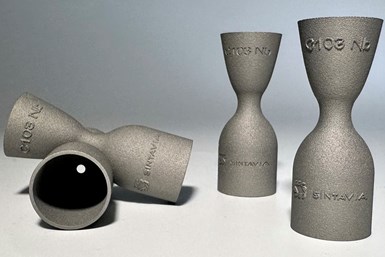Sintavia Develops Niobium Printing Technology for Aerospace, Defense
C103 material parameter specification is said to enable full alloy adoption across defense and space applications.
Sintavia — a designer and additive manufacturer of complex mechanical systems for the aerospace, defense and space industry — has developed material parameters for alloy C103, a high-performance niobium alloy which is well suited for rocket, jet and satellite propulsion applications.
The refractory metal, which is difficult to print without extensive parameter development, was developed on an EOS M290 printer and represents the 29th material parameter developed by Sintavia for use by its aerospace, defense and space OEM customers.
The mechanical properties of Sintavia’s C103 include an as-printed density of 99.94% and a Z-direction elongation of 32% after a standard stress relief cycle. Full performance data for Sintavia’s C103 parameter set can be found on the company’s website.
“Due to its extremely high melting point, niobium is widely recognized as an excellent material for space propulsion applications, specifically reaction control thrusters and attitude control thrusters,” says Pavlo Earle, Sintavia’s vice president of technology engineering. “With this development, Sintavia is able to offer its space customers components that embody industry-leading mechanical properties. When combined with Sintavia’s equally best-in-class design and additive production capability, our C103 parameters offer our customers a high-quality and reliable industrial solution for extreme temperature applications.”
Sintavia is currently developing standards for other refractory materials for use across the aerospace, defense and space industry. The company designs and 3D prints advanced propulsion and thermodynamic systems for customers in the aerospace and defense industry. A founding member of the Additive Manufacturer Green Trade Association, Sintavia is committed to the highest quality standards in the industry and holds multiple Nadcap and other aerospace accreditations.
- Additive manufacturing has not yet fully confronted all the factors that contribute to sustainability. Learn how Sintavia is discovering and working through these issues in metal AM as its production work scales.
- Read about Sintavia’s development of proprietary copper printing technology which is designed for use with GRCop-42, the preferred copper alloy used by NASA and private space flight companies for rocket thrust chamber assemblies.
Related Content
-
Quadrus: Powder Management Tactics for Tungsten Rhenium and Other AM Alloys
The expert in additive manufacturing of high-value parts for the Defense Department often must change from one exotic material to another in its powder bed machines. Cleaning is a core competency. Here are lessons of this company’s system for working with an ever-changing mix of 3D printed alloys.
-
New Zeda Additive Manufacturing Factory in Ohio Will Serve Medical, Military and Aerospace Production
Site providing laser powder bed fusion as well as machining and other postprocessing will open in late 2023, and will employ over 100. Chief technology officer Greg Morris sees economic and personnel advantages of serving different markets from a single AM facility.
-
Additive Manufacturing for Defense: Targeting Qualification
Targeting qualification in additive manufacturing for the defense industry means ensuring repeatability as well as reliability as there is much at stake, including human lives. Certain requirements therefore must be met by weapons systems used by the defense industry.















